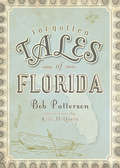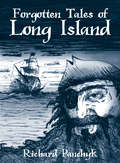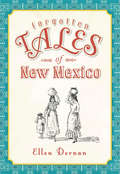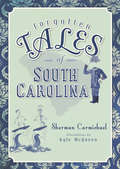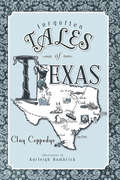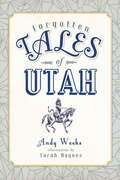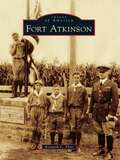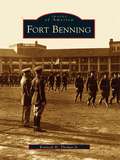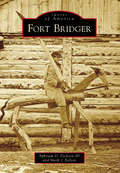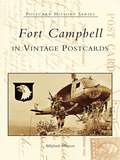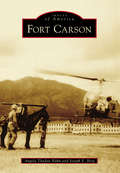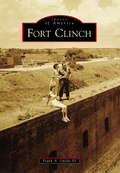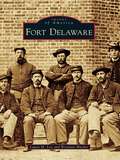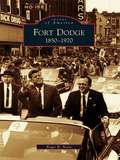- Table View
- List View
Forgotten Tales of Colorado (Forgotten Tales)
by Stephanie WatersWild characters, diverse cultures, spooky myths and slippery sales schemes color Colorado's past. In a place where shameless showdowns and dusty shootouts over money, drink and women were once standard procedure, storytelling around campfires became an integral part of a rich heritage. From the jackalope and vampires to Indian curses and snake oil salesmen, the Centennial State has it all. Weirder still are the strange but true stories like that of the first body buried in La Junta's Fairview Cemetery, a man who landed there for refusing alcohol to a kid, and that of the hotel in Telluride that once offered a promotion that included funeral costs with your stay. While history may have neglected these silly, seedy and salacious stories, author Stephanie Waters has rediscovered Colorado's best forgotten tales.
Forgotten Tales of Florida (Forgotten Tales)
by Bob PattersonWith such a rich and significant history, it�s only natural that some of the best stories from the Sunshine State have been forgotten over time. Thankfully, master storyteller and St. Augustine resident Bob Patterson offers this collection of thestrangest, most fascinating stories and legends in Florida�s history from coast to coast, swamp to swamp. Enjoy the saga of William Ellis, a North Florida nature whisperer who escaped from his nursing home with the help of his varmint friends; step into the murk and mystery of the vanishing tribes of the Everglades; and could there really be gator-hungry sharks lurking in the St. John�s River? These stories and so many moreawait when you explore the Forgotten Tales of Florida.
Forgotten Tales of Illinois (Forgotten Tales)
by Bryan AlaspaDig up the men who tried to dig up Lincoln. Mull over the Mad Gasser of Mattoon and the 1977 thunderbird infestation, from a safe distance. Watch in horror as one of the greatest maritime disasters in U.S. history occurs twenty feet from the banks of the Chicago River or follow the course of the blimp crash that convinced a downtown bank employee that it was raining hell. Try not to blink as towns washed away by floods and shrines covered over by condominiums are dragged back from the margins of history into the center of the page, where they belong. After all, reasons author Bryan Alaspa, if the pope was eager to stop by the House of Crosses during his visit to Chicago, surely it is worth a look. Just beware: a quick glance into this book and you might not look up until you've read the whole gripping and grin-inspiring collection.
Forgotten Tales of Long Island (Forgotten Tales)
by Richard PanchykIn this enthralling new book, Richard Panchyk has compiled a collection of true stories from Long Island�s history sure to befuddle, baffle and bemuse even lifelong residents. Who knew that Plum Island was bought with a barrel of biscuits and a few fishhooks? Or that an Oyster Bay woman accused of being a witch was instead found guilty of being a Quaker? Little-known tales of snake-eyed horses, naked ghosts, swamp serpents and cats riding horses offer a fresh look at Long Island�s past. Culled from numerous period sources, including newspapers, books and historical records, these little stories are notable both as entertaining anecdotes and as forgotten history.
Forgotten Tales of New Mexico (Forgotten Tales)
by Ellen DornanNew Mexico, a place defined by a history of grand conflicts, conquistadores, Pueblo warriors, and nuclear scientists, will celebrate its state centennial in 2012. What better time for a collection of forgotten tales that recounts the adventures and exploits of priests, soldiers, witches, and politicians, who carved out a living in the harsh frontier. Ellen will introduce the reader to a cross-dressing Buffalo Soldier, a French trailblazer who opened a road from Santa Fe to Texas, an American spy who became a Mexican general, a Mexican raised by the Navajo who helped round up the Din for removal, and a governor whose head was removed and used as a football. Spanning from the 17th century to World War II, these stories are drawn from Native oral histories as well as the state's written records, and provide a sampling of New Mexico's colorful past.
Forgotten Tales of Pennsylvania (Forgotten Tales)
by Thomas White Marshall HudsonWilliam Penn, the might of Pittsburgh steel and the Revolutionary figures of Philadelphia dominate the scene of Pennsylvania history. Thomas White brings together a collection of tales that have been cast in the shadows by these giants of the Keystone State. From the 1869 storm that pelted Chester County with snails to the bloody end of the Cooley gang, White selects events with an eye for the humorous and strange. Mostly true accounts of cannibalistic feasts, goat-rescuing lawmen, heroic goldfish, the funeral of a gypsy queen and a Pittsburgh canine whose obituary was featured in the New York Times all leap from the lost pages of history.
Forgotten Tales of South Carolina (Forgotten Tales)
by Sherman CarmichaelFrom the desk of Sherman Carmichael comes a collection of about a hundred quirky and unpublished tales from the Palmetto State. Tales include everything from folk tales, urban legends, monsters, mermaids, ghost sightings, mysterious lights, UFO sightings, dinosaurs, and haunted locations.
Forgotten Tales of Texas (Forgotten Tales)
by Clay CoppedgeFrom El Chupacabra to the Marx Brothers, Clay Coppedge has a talent for digging into Texas's most unusual history. Strange as they may seem, many of these Texas-sized legends are surprisingly true, like Pancho Villa's film contract and the notorious Crash at Crush, a staged train collision and failed publicity stunt that turned tragic outside of Katy. Whether fact or lore, each tale is irrefutably part of a unique and fascinating heritage that invigorates the spirit like a Texas frontier remedy.
Forgotten Tales of Utah (Forgotten Tales)
by Andy WeeksCharacters ranging from Mormon pioneers to Butch Cassidy all helped give the Beehive State color and tenacity. Uncover the state’s hidden gems with stories like the first group of Latter-day Saints who arrived in the Salt Lake Valley days before Brigham Young proclaimed it as “the right place.” Meet an ancient prophet believed to have walked the arid landscape, offering his blessing on several sites long before the pioneers arrived. Learn why a former lawyer was buried without a proper headstone. Discover the state’s quirky side with the strange goings-on at an obscure ranch and the alleged monsters once believed to haunt some of Utah’s lakes. Author Andy Weeks offers this quirky and informative collection of little-known tales about the forty-fifth state.
Fork It Over: The Intrepid Adventures of a Professional Eater
by Alan RichmanAdventures in eating by the twelve-time James Beard Award winner: “Richman’s dry, witty prose will delight readers who crave good culinary writing.” —Library JournalAlan Richman has dined in more unlikely locations and devoured more tasting menus than any other restaurant critic alive. He has reviewed restaurants in almost every Communist country (China, Vietnam, Cuba, East Germany) and heedlessly indulged his enduring passion for eight-course dinners (plus cheese). In Fork It Over, Richman retraces decades of culinary adventuring. In one episode, he reviews a Chicago restaurant owned and operated by Louis Farrakhan (not known to be a fan of Jewish restaurant critics) and completes the assignment by sneaking into services at the Nation of Islam mosque, where no whites are allowed. In Cuba, he defies government regulations by interviewing starving political dissidents, and then rewards himself with a lobster lunch at the most expensive restaurant in Havana. He chiffonades his way to a failing grade at the Paul Bocuse school in Lyon, politely endures Sharon Stone’s notions of fine dining, and explains why you can't get a good meal in Boston—spurred on by the reckless passion for food that made him the only soldier he knows who gained weight while in Vietnam and carried him from his neighborhood burger joint to Le Bernardin.“A sharp, rollicking collection of articles documenting Richman’s most memorable culinary experiences . . . An enjoyable treat full of gastronomic guffaws.” —Kirkus Reviews (starred review)“Reading Richman is like taking a brisk walk with a very funny friend.” —Entertainment Weekly“From Shanghai to Havana to the Hamptons, Richman knows whereof he speaks, and he says it so well you can almost taste it.” —Forbes“A very satisfying feast.” —Associated Press
Fork on the Road: 400 Cities/One Stomach
by Mark DecarloA seasoned comedian’s love letter to America’s food curiosities—the regional cuisines, the culinary oddities, the weird and the wonderful“Mark DeCarlo is a [modern-day] Groucho Marx.” —PEOPLEWhether it be fish ice cream, kudzu tempura, or even sausage, Mark DeCarlo always wonders, “Who the hell thought to eat this stuff the first time?” We find out in this hilarious celebration of the genesis of America’s most creative and idiosyncratic food traditions, and the people who keep these food traditions alive. Join the master comedian on his journey across the United States to visit these people and their foods in their natural habitats—places like the French Quarter of New Orleans, lush Maui resorts, and the Annual Road Kill Cook-off Festival in West Virginia. From the obvious and beloved (Buffalo wings, Boston clam chowder, hush puppies, and strawberry shortcake) to the bizarre and, well, beloved by some (Rocky Mountain oysters, fried rattlesnake, scrapple, and deep fried Twinkies), DeCarlo takes readers on a rollicking tour of the people and places behind America’s greatest food inventions. Each chapter features the story behind a particular food (moosehead soup, anyone?) and the people who love it. Signature recipes, snapshot photos from the road, along with “Road Rules” on how to discover the real America all spice up the travelogue. It's a love letter to America’s culinary curiosities, providing armchair travelers with a tour of the wackiest and kitschiest food festivals, delicacies, and people this country has to offer. FROM THE AUTHOR'S FOREWORDConsider the oyster. Unopened, dirty, and habitually covered with muddy, green crap. If you didn’t know that it was hollow and contained a tasty glob of salty protein, would you ever guess that this rock was edible? Well . . . somebody did. Deep in the recesses of time, some caveman or beach-dwelling ape not only discovered that oysters aren’t rocks . . . but that they’re tasty—as long as you’ve got Tabasco and a date for the night. But for every ‘oyster,’ success story, there are thousands of casualties that will forever remain unknown. History is written by the survivors. A Fork on the Roadcelebrates those survivors and their progeny: It’s about the kinds of people who will spend 30% of their yearly salary building a BBQ Trailer with a homemade logo painted in flames on the side just to win a $50 contest 500 miles from home. It’s about the third generation pie maker who is as dull as a hammer until the conversation comes around to “cracker” versus “pastry” shells. It’s about the millions of people around the country who call themselves ‘foodies’—as if the rest of us exist simply on air and water. . . .
Forked: A New Standard for American Dining
by Saru Jayaraman<p>A restaurant critic can tell you about the chef. A menu can tell you about the farm-sourced ingredients. Now who's going to tell you about the people preparing your meal? <p>From 2015 James Beard Leadership Award winner Saru Jayaraman, Forked is an enlightening examination of what we don't talk about when we talk about restaurants: Is the line cook working through a case of stomach flu because he doesn't get paid sick days? Is the busser not being promoted because he speaks with an accent? Is the server tolerating sexual harassment because tips are her only income? <p>As most corporate restaurants continue to set low standards for worker wages and benefits, a new class of chefs and restaurateurs is working to foster sustainability in their food and their employees. Forked offers an insider's view of the highest--and lowest--scoring restaurants for worker pay and benefits in each sector of the restaurant industry, and with it, a new way of thinking about how and where we eat.</p>
Formula One Racing For Dummies
by Jonathan NobleA crash course in the exciting world of professional motor racing Formula One Racing For Dummies has all the information you need to start following this exciting motor sport. You’ll learn the basic dynamics and rules of F1, and you’ll get a primer on the drama, strategies, politics, and rivalries that have turned the sport into a global sensation. Written by an industry expert, this book is full of fun anecdotes that will get beginners and die-hards alike excited for the next race. Get to know the contemporary F1 scene, with profiles of current team managers and drivers, info on the best media coverage and F1 news sources, and the latest rules and technical regulations. For fans who watch F1 on TV and those who attend the races in person, this fast-paced Dummies guide is a perfect way to bolster your enjoyment of the sport. Discover the anatomy of Formula One racecars, including hybrid engines and modern safety systems Learn what goes on behind the scenes, so you know what’s at stake when you watch races Get to know the most popular drivers, their racing styles, and their backstories Familiarize yourself with the championships, pit stops, and new tracksFollowing F1 is a lot more exciting when you have a little knowledge about the sport. Formula One Racing For Dummies, the Grand Prix of racing guides, will teach you the ins and outs.
Fort Atkinson (Images of America)
by Kenneth C. FlintFort Atkinson has been called the "top historical spot in Nebraska," the "SAC of 1820," and "America's most important Western outpost." Once the country's largest fortress beyond the Missouri River, its garrison protected America's interests in the burgeoning fur trade, provided a base camp for explorations, played host to famous frontiersmen, and was the site where numerous treaties were signed. But by 1961, Fort Atkinson was endangered. The fort's buildings had vanished over 100 years before. Decades of farming on the land had nearly erased its footprint. A housing development threatened to obliterate the site forever. There was only a marker with a flagpole raised in 1927 by the Daughters of the American Revolution--a lonely object in the midst of an empty plain. This book tells the story of how that lost fortress was restored to become the major state historical park it is today.
Fort Benning (Images of America)
by Kenneth H. Thomas Jr.Established outside Columbus, Georgia in October 1918 by the United States Army as Camp Benning, the base was moved to its permanent location, nine miles south, in June 1919. In 1922, the post was made permanent and was named Fort Benning. Created as the new location of The Infantry School of Arms, Fort Benning became the training post for many of the country's future leaders, as well as a major part of the military experience for hundreds of thousands of American soldiers.The post's current size, more than 180,000 acres, has long made it recognized as one of the largest infantry bases in the world. Named for Gen. Henry L. Benning of Columbus, the installation has had a major impact on the economic and social life of nearby Columbus. Images of America: Fort Benning features vintage photographs and postcards, mostly from 1918 to 1978, showcasing the first 60 years of the base's 85-year history. Included are scenes of the temporary encampment on Macon Road and the early wooden encampment on the Main Post. The permanent buildup from the late 1920s to the early 1940s is shown in photographs of The Infantry School, the Officers' Club, Main Post Chapel, Doughboy Stadium, Gowdy Field, the Jump Towers, Lawson Field, the Cuartel Barracks, and the officers' quarters, as well as Riverside, the Commandant's Home, formerly the Bussey Plantation. Activities and events include military reviews, visits of presidents, and the National Infantry Museum's dedication. Generals who served there and are featured include Bradley, Eisenhower, Marshall, and Patton.
Fort Benton (Postcard History Series)
by Ken RobisonFort Benton, the head of navigation on the Missouri River, is known as the "Birthplace of Montana." Its history spans every era in Montana's development. Founded in 1846 as a fur-trading post, it is Montana's oldest continuous settlement. Arrival of the first steamboats and completion of the Mullan Road in 1860 heralded the steamboat era, bringing gold seekers, merchant princes, scoundrels, soldiers, North West Mounted Police, and eventually women and children to the wild frontier. Then came the railroads, open-range ranching, and homesteaders by the thousands. Today Fort Benton serves the agricultural Golden Triangle and presents its colorful history through cultural tourism.
Fort Bridger (Images of America)
by Ephriam D. Dickson III Mark J. NelsonThe history of Fort Bridger represents a microcosm of the development of the American West. Situated in an area initially inhabited by the Shoshone people, Fort Bridger was established during a transitional phase between the fur-trade era and the period of western migration. The fort became one of the most important supply points along the nation's western trail network. Later, the post served as a bastion of civilization as one of a number of western military posts. Soldiers at the fort protected not only the lives and property of its local citizenry but also the emerging transportation and communication advancements of a nation. Following the Army's departure, a small settlement emerged at Fort Bridger, using buildings and materials from the old military garrison. Today, the fort and town remain active, in part as a respite for travelers just as it had been more than 150 years ago.
Fort Campbell in Vintage Postcards (Postcard History Series)
by Billyfrank MorrisonSince its establishment in 1941, Fort Campbell, Kentucky, has grown to approximately 30,000 soldiers on over 100,000 acres. With its Southern culture, the base has a rich and interesting history. German prisoners of war were held here during World War II, and Campbell Army Air Field has always been a favorite stopover of NASA shuttle crews. Fort Campbell units have inspired numerous movies and books, such as Black Hawk Down, Band of Brothers, and ShadowWarriors. Through over 200 vintage postcards and photographs, this pictorial history tells the unique story of an army base and its brave soldiers who have fought to defend our country.
Fort Carson (Images of America)
by Angela Thaden Hahn Joseph E. BergArmy scout Kit Carson rode the Southwest in many capacities. He served and retired in Colorado, and so Fort Carson is appropriately named. On land once traversed by Lt. Zebulon Pike, Camp Carson was constructed almost overnight under the watchful eye of Pres. Franklin Roosevelt and with the approval of the neighbors in Colorado Springs. Since its creation, the post has been the home and training grounds for thousands of soldiers who have fought in all wars from World War II to the current war on terror. Fort Carson continues to be a valuable asset to the community economically and in its generosity with resources when a local need arises.
Fort Clinch (Images of America)
by Frank A. Ofeldt IIIAs part of the third system of fortifications built for harbor defense, Fort Clinch was constructed from 1847 to 1867. Serving in three wars, the Civil War, Spanish-American War, and World War II, the fort never saw battle and was never fully completed. Offered for public sale in 1926, Fort Clinch was sold by its owners to the State of Florida in 1935 and became one of the first nine Florida state parks. The fort was partially restored by the Civilian Conservation Corps from 1937 to 1942. Later, the Florida Park Service performed a more comprehensive restoration from 1963 to 1971 and created one of the finest living history programs in the country, offering an interpretation of Fort Clinch as it was in 1864, when the federal army occupied the fort and Amelia Island. Today, Fort Clinch State Park offers a wide range of recreation resources to visitors.
Fort Collins: The Miller Photographs
by Barbara Fleming Malcolm McneillPhotographer Mark Miller opened his studio in Fort Collins, Colorado, in 1914. The town he chose to live and work in sits in a river valley in northern Colorado, nestled between the Rocky Mountain foothills and the semiarid high plains, with Denver to the south and Cheyenne, Wyoming, to the north. Established as a Civil War-era army post, the town was a Wild West frontier outpost until it was tamed in the 1870s by the arrival of a land-grant college and the railroad. By the turn of the century, Fort Collins had become a quietly respectable college town with a thriving economy and steadily increasing population. Over almost six decades, as the small town evolved into a city, Miller photographed people, businesses, and landscapes. Fort Collins: The Miller Photographs offers a representative sampling of the over 70,000 Miller images, a collection housed at the Fort Collins Museum's Local History Archive.
Fort Delaware (Images of America)
by Brendan Mackie Laura M. LeeLocated on Pea Patch Island, Fort Delaware was erected to defend local ports from enemy attack but never received or fired a shot in anger. The first earthen-work version, constructed during the War of 1812, was followed by a second 1820s plan incorporating a masonry star design with a network of drainage ditches. Engineering issues and a low-lying site doomed the structure; in 1831, it was irreparably damaged by fire. A new plan created a more substantial fortification still standing to this day. Fort Delaware evolved into a well-established community that transformed from protector to notorious Civil War prison camp. Most widely known as a prison, it subsequently served in lesser roles through three more conflicts. Images of America: Fort Delaware unifies an amazing pictorial record of Fort Delaware's historical timeline. The story is not only of active duty but its rescue from abandonment and subsequent successful preservation work.
Fort Devens (Images of America)
by William J. CraigThe geographical location of Fort Devens has a military history that dates back to the 1600s, when the area was first garrisoned by British troops. In 1915, the region was again chosen for a cantonment, one of only sixteen in the country. In order to build the camp, the War Department assembled the largest labor force in history. New buildings sprang up at the rate of about ten per day and supported more than one hundred thousand troops that were processed at Camp Devens, as it was originally named, during World War I.Fort Devens is the first book to trace the military activity in this area. Throughout the twentieth century, troops were trained and deployed from Fort Devens for every major conflict the United States was involved in. During World War II, Fort Devens inducted more than six hundred thousand men into the army from the New England area. The list of individuals who have served here included Pulitzer Prize-winning cartoonist Bill Mauldin, Secretary of State Colin L. Powell, and Senator Edward M. Kennedy. Even NASA can trace its birth to Fort Devens by way of Dr. Robert Goddard's liquid-fueled rocket experiments.
Fort Dix (Images of America)
by Daniel W. ZimmermanLocated in central New Jersey, Fort Dix has been training soldiers since its founding in 1917. More than three million men and women have passed through its gates since it was built as one of the original sixteen army camps to train and mobilize soldiers for World War I. Using historical images, Fort Dix chronicles the history of life in an army camp from 1917 to the present. The fort, once known as Camp Dix, has experienced many changes over the years. This unprecedented photographic history traces the evolution from a wooden cantonment to the installation of brick and fiber optics, from a horse-dominated transportation system to a motor vehicle system, and from training recruits to serving Army Reserve and National Guard soldiers. Along the way, Fort Dix depicts the influence of the 78th Division, the Civilian Conservation Corps, the Women's Army Corps, Desert Storm, and the humanitarian work of resettling the Kosovo refugees.
Fort Dodge: 1850 to 1970
by Roger B. NatteFort Dodge was founded in 1850 as a military post to police the Iowa frontier. A subsequent land boom created fortunes that were reinvested in the local economy. The town soon earned the nickname "Mineral City" because of the extensive deposits of coal, gypsum, limestone, and clay. By 1900, the city was a rail center and the world's largest producer of gypsum products. With a highly diversified economy, the city prospered and by World War I was able to claim to have more skyscrapers per capita than any other city in the Midwest and beautiful public buildings designed by some of the nation's leading architects. Between 1900 and 1925, Fort Dodge enjoyed the role as an important political center and the home of two U.S. senators, the director of the U.S. Mint, the solicitor of the Department of the Treasury, a judge on the U.S. Court of Appeals, Eighth Circuit, and the first presidential press secretary and speechwriter. Sons and daughters of the community went on to establish national reputations in art, music, literature, science, and journalism. Images used in this volume come primarily from the archives of the Webster County Historical Society and were chosen to represent the changing character of the community from 1850 to 1970.

